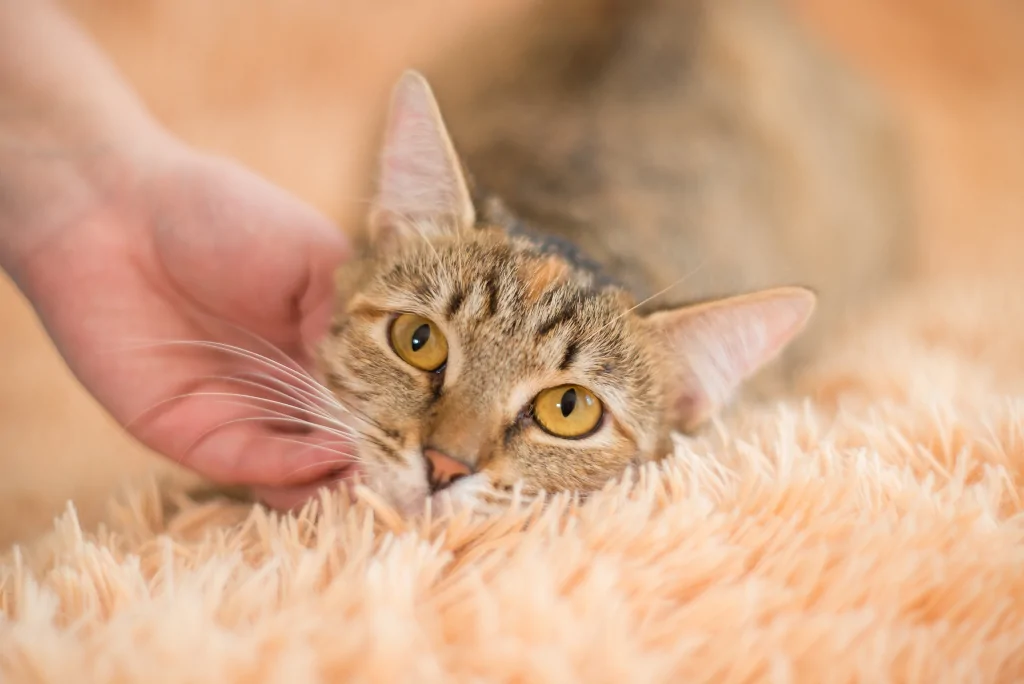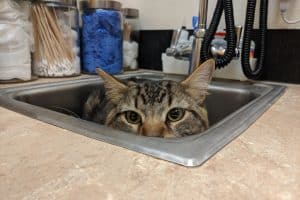Note: We may earn a commission from helpful, relevant links in our content. No cost to you. See our privacy policy.
Ah, the eternal battle against those pesky fleas! As a cat owner, you know how frustrating it can be to see your beloved pet constantly scratching and feeling miserable.
Not only are fleas irritating for your cat, but they can also lead to health problems and infest your home. In this blog post, we’ll arm you with the knowledge and tools to defeat these tiny invaders, ensuring a happy, itch-free life for your feline friend.
Get ready to embark on a journey to a flea-free world where your cat can roam without worry, as we share valuable insights, helpful tips, and a pinch of wit along the way.

Why Flea Prevention and Treatment Matter
Protecting your cat from fleas is crucial for their comfort and overall health. These tiny parasites feed on your cat’s blood, causing irritation, itchiness, and even allergies in some cases.
When left unchecked, fleas can lead to severe skin infections and transmit diseases like tapeworms or cat-scratch fever.
By preventing and treating flea infestations, you’ll keep your cat healthy and your home free from these unwelcome guests.
Flea Life Cycle: Understanding the Enemy
Effectively combating fleas requires understanding their life cycle.
Fleas go through four stages: eggs, larvae, pupae, and adults. Adult fleas lay eggs on your cat, which then fall off and hatch into larvae in your home.
These larvae develop into pupae, encased in a protective cocoon, and later emerge as adult fleas, ready to infest your cat once again.
By knowing their life cycle, you can target fleas at every stage, ensuring a more thorough and lasting victory over these persistent parasites.
Best Flea Prevention Methods for Cats
Effective flea prevention requires a combination of strategies to protect your cat and keep your home free from these pests. Here are some popular and proven methods to prevent flea infestations in your feline companion.
Topical Treatments
Topical treatments, also known as spot-on treatments, are a favorite among cat owners for their ease of use and effectiveness.
These liquid medications are applied directly to your cat’s skin, typically between the shoulder blades or at the base of the neck. They work by spreading through the cat’s natural oils, killing adult fleas and sometimes even targeting other stages of the flea life cycle.
Some popular and effective options include:
- Advantage II,
- Frontline Plus, and
- Revolution.
Remember that these treatments are weight-specific, so make sure to choose the correct dosage based on your cat’s weight to ensure maximum effectiveness.
Try to always follow the manufacturer’s instructions and consult with your vet if you have any concerns, even if it’s your first vet visit.
Oral Medications
Oral flea medications offer an alternative to topical treatments. These pills or chewable tablets are given to your cat, usually once a month, to eliminate fleas from within.
Some oral medications kill adult fleas, while others target flea larvae or eggs. Examples of oral flea preventatives include:
- Capstar,
- Comfortis, and
- Bravecto for cats.
Make sure to consult your veterinarian before starting any oral medication to ensure it’s suitable for your cat’s age, weight, and health conditions.
Some cats may experience side effects, such as vomiting or diarrhea, so it’s essential to monitor your pet closely after administering the medication and notify your vet if any adverse reactions occur.
Flea Collars
Flea collars can be an effective and low-maintenance method of flea prevention for cats. They work by releasing insecticides that kill fleas and, in some cases, repel them.
When choosing a flea collar, look for reputable brands like Seresto, which provide long-lasting protection, up to eight months in some cases.
Make sure the collar is properly fitted and replaced as needed for the best results. To avoid irritation or injury, ensure there’s enough space for two fingers to fit comfortably between the collar and your cat’s neck, and regularly check for any signs of chafing or discomfort.
Additionally, be aware that some cats may be sensitive to the chemicals in flea collars, so monitor your pet closely for any signs of discomfort or adverse reactions. Be sure not to put dog collars on your cat, for several reasons.
How to Identify a Flea Infestation in Your Cat
Catching a flea infestation early is crucial to prevent further complications and make treatment more effective. Here are some telltale signs and tips to help you identify a flea problem in your feline friend.
- Excessive scratching, biting, or licking. Fleas cause itchiness and discomfort, leading your cat to scratch, bite, or lick their fur more than usual. Pay attention to any changes in your cat’s grooming habits, especially if they seem to focus on specific areas like the base of the tail or around the neck.
- Redness, irritation, or scabs. Flea bites can cause redness, skin irritation, and even scabs on your cat’s skin. If you notice these symptoms, inspect your cat more closely for fleas and seek appropriate treatment.
- Flea dirt. Flea dirt, or flea feces, looks like small black specks resembling ground pepper. These can be found on your cat’s skin or bedding. To confirm it’s flea dirt, place a few specks on a damp white paper towel. If they dissolve into reddish-brown stains, it’s likely flea dirt, which is a sign of an infestation.
- Live fleas. While fleas are tiny and fast, you may be able to spot them on your cat or in their bedding. Using a fine-toothed flea comb, gently comb through your cat’s fur, focusing on the neck and tail base areas. If you find live fleas or more flea dirt, it’s time to take action.
- Hair loss or bald patches. In some cases, cats may develop hair loss or bald patches due to excessive scratching, biting, or licking caused by flea irritation. If you observe this issue, consider flea infestation as a potential cause and consult your veterinarian.
Remember to keep an eye on your cat’s behavior and appearance, as early detection can make a significant difference in managing a flea infestation. And if your cat is stressful around vets, check our guide on what you can do to calm your cat.
While dealing with fleas, it’s also essential to be aware of other parasites that can affect your cat, such as ear mites, which you can learn in our full guide here.

Safe and Effective Flea Treatments for Cats
Choosing the right flea treatment for your cat can be daunting with the variety of options available. In this section, we’ll discuss safe and effective methods to eliminate fleas, ensuring your cat’s comfort and well-being.
Over-the-counter Solutions
Over-the-counter flea treatments can be an accessible and affordable option for many cat owners.
These treatments include topical spot-on solutions, oral medications, and flea shampoos. Some popular and reliable brands for topical treatments are Advantage II and Frontline Plus, while Capstar is a well-known oral medication.
Flea shampoos can provide quick relief, but they may not offer long-term protection. Make sure to read labels carefully and choose products specifically formulated for cats, as some ingredients in dog flea treatments can be toxic to cats.
Prescription Medications
For more severe infestations or when other treatments haven’t been effective, your veterinarian may recommend prescription medications.
These may include stronger topical solutions or oral medications, like Bravecto for cats, which offers up to 12 weeks of protection. Your vet may also suggest a combination of treatments to address various stages of the flea life cycle.
Always consult your veterinarian before starting any prescription treatment to ensure it’s safe and suitable for your cat.
Natural Remedies
If you prefer a more natural approach, there are alternative flea treatments to consider. However, keep in mind that natural remedies may not be as effective as conventional treatments, and their safety and efficacy can vary. Some common natural flea control methods include:
- Diatomaceous earth. A non-toxic powder made from crushed fossils, diatomaceous earth can be sprinkled on your cat’s bedding or other infested areas to help control fleas. Use only food-grade diatomaceous earth and avoid applying it directly to your cat’s fur.
- Flea comb. Regularly combing your cat with a fine-toothed flea comb can help remove adult fleas, flea dirt, and eggs. It’s a chemical-free approach but requires persistence and consistency for the best results.
- Essential oils. Some essential oils, like lavender and lemongrass, are believed to have flea-repelling properties. However, be cautious when using essential oils around cats, as some can be toxic. Always dilute the oils and consult your veterinarian before using them on or near your pet.
Remember that every cat is different, and what works for one may not be suitable for another, and always consult your vet before trying any new flea treatments to ensure they’re safe and effective for your specific cat. Naturally, regular vet checkups are recommended.
Tips for Managing Flea Infestations in Your Home
Treating your cat is just one part of the battle against fleas. You also need to address the infestation in your home. Here are some useful tips to help you tackle fleas in your living space and prevent future infestations.
- Vacuum thoroughly and regularly. Vacuuming is an essential step in flea control. It helps remove fleas, eggs, and larvae from carpets, rugs, and upholstery. Be sure to vacuum all areas where your cat spends time, and don’t forget to clean under furniture and in tight spaces. Dispose of the vacuum bag or empty the canister immediately after each session to prevent fleas from re-infesting your home.
- Wash bedding and soft furnishings. Launder your cat’s bedding, as well as any blankets, cushions, or soft toys they come into contact with. Use hot water and high heat in the dryer to kill any fleas, larvae, and eggs that may be present.
- Use flea sprays or foggers. Flea sprays or foggers can help eliminate fleas in your home, targeting areas where they may hide. Choose a product specifically designed for indoor use and follow the instructions carefully. Make sure to remove your cat and any other pets from the area during treatment and ventilate the space thoroughly afterward.
- Treat your yard. Fleas can thrive in outdoor environments, so it’s essential to address infestations in your yard as well. Use outdoor flea treatments, like sprays or granules, and focus on areas where your cat spends time, such as shaded spots and areas with tall grass or bushes.
- Maintain a regular flea prevention routine. To keep fleas at bay, stick to a consistent flea prevention regimen for your cat. Follow the recommended schedule for any treatments you’re using, and consult your veterinarian if you’re unsure about the best approach for your pet.
By combining effective flea treatments for your cat with thorough home and yard management, you’ll be well-equipped to keep these pesky pests under control, ensuring a comfortable and healthy environment for you and your feline friend. For tick prevention, see this guide.
Conclusion: Keeping Your Cat Flea-Free and Healthy
As you embark on this mission to protect your beloved feline friend from the pesky foes that are fleas, remember that diligence, patience, and a comprehensive approach are your greatest allies.
With consistent prevention measures and an attentive eye for any signs of infestation, you’ll be well on your way to providing a healthy, comfortable, and flea-free haven for your cat.
Celebrate the bond you share with your feline companion by taking the time to understand their needs and ensuring their well-being. After all, a happy, itch-free cat makes for a happier home and a more gratifying pet-parenting journey. Get more tips from our guides for cat owners.
FAQs
Can fleas transmit diseases to cats?
Yes, fleas can transmit diseases such as cat scratch fever and tapeworms to cats. Additionally, they can cause anemia due to excessive blood loss from the bites.
Are some cats more prone to flea infestations than others?
All cats are susceptible to fleas, but outdoor cats or those with compromised immune systems may be more vulnerable. Cats with long fur may also provide an ideal environment for fleas to hide.
How long do flea treatments usually take to work?
Flea treatments can start working within hours, but it may take a few days to weeks to eliminate an infestation completely. The duration depends on the severity of the infestation and the specific treatment used.
Can fleas survive in cold weather?
Fleas can survive in cold weather, but they are less active and reproduce more slowly. However, warm and humid indoor environments can sustain flea populations year-round.
Alex, a passionate animal lover, has experience in training and understanding animal behavior. As a proud pet parent to two dogs and three cats, he founded AnimalReport.net to share insights from animal experts and expand his knowledge of the animal kingdom.









